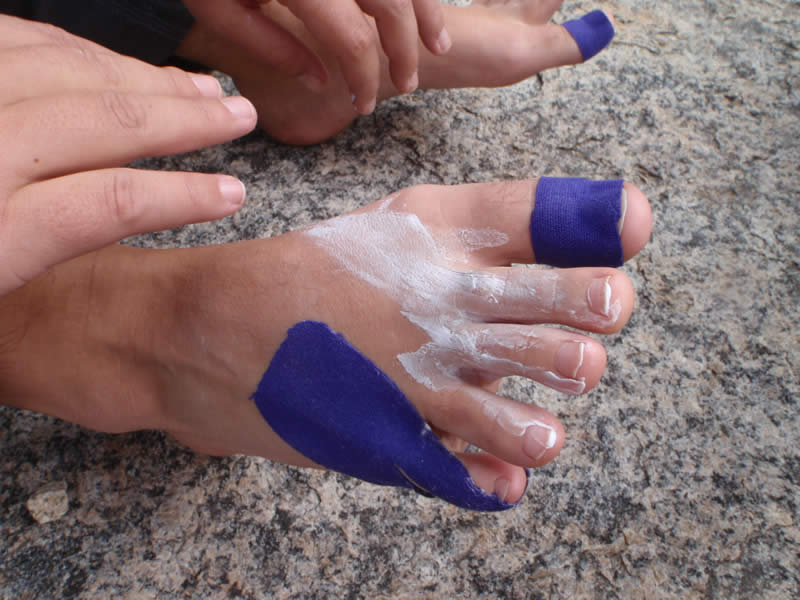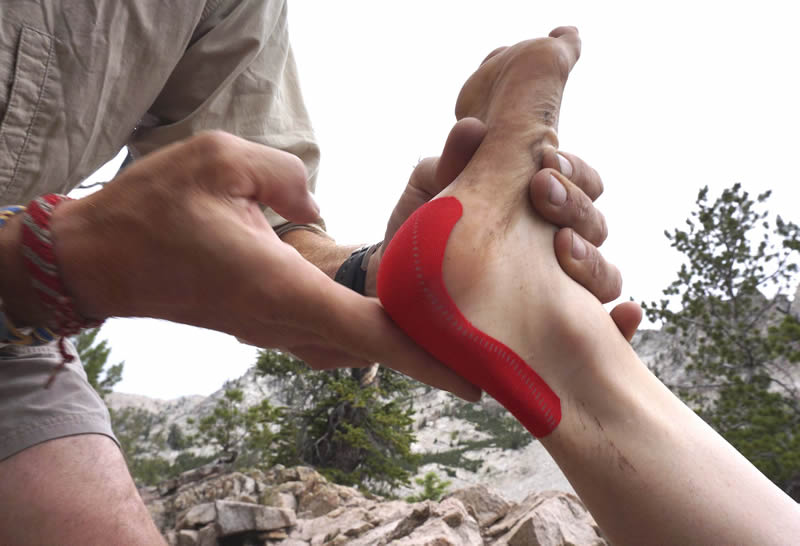Foot blisters are one the most common maladies suffered by backpackers and trail runners, and dealing with them properly can be both challenging and maddening. I have been witness to scores of spectacular serum-filled cavities, delaminated swathes of tissue, and windows to the depths of the human foot. There is only one solution: prevention. If this fails, then what?
First, let's review how the foot moves during a stride and how that relates to blister formation. When walking on level ground in supple running shoes, the calcaneus normally moves up and down during a normal stride and the heel of the shoe is pulled up along with it, as well as any sock material in between. If the sole of the shoe has great flexibility in the forefoot region, then the shoe will respond to the movement of the calcaneus easily, decreasing the potential for friction between the skin and the shoe and/or sock material. If the sole of the shoe is rigid (i.e. traditional hiking boots), if the grade of the slope is increasing (hiking uphill), or if the calf muscles are tight (decreased ankle flexibility), then the calcaneus rides up and down against a resistive force (the heel counter of the shoe) and the shear forces over this tissue rise dramatically. A blister occurs when the tissue planes are separated by those shear forces, creating a potential space which then fills with fluid.

When it comes to blister prevention, the first thing to consider is footwear because the prevention of blisters can be thought of as more of a potential reduction in the blisters that may be experienced. Trading in your traditional lug-soled leather boots for a pair of highly technical trail runners is probably the first thing that can be done to create a pair of harmoniously happy feet. But what about ankle support, you may ask? Counter to all of the salesmen's advice, there is only ankle protection with standard boots and not support (high altitude mountaineering boots being the exception). Needing ankle support for backpacking on a trail in Yellowstone, and not needing it during the Wasatch 100 endurance race seems ironic.
After updating the footwear, it's time to glean some knowledge from a group of endurance athletes whose feet take a fair bit of abuse - ultramarathon runners. What is the common thread for most of these trail runners? The majority of them wear Injinji© socks (thin five-toed liner socks) often layered with another pair of traditionally shaped trail socks, technical trail running shoes that are 1/2 - 1 size too big, and some form of skin lubricant (BodyGlide©) in areas of known concern. Just doing these three simple things could result in days and days of beautiful landscapes, without a hint of wincing pain.

The final ingredient used by the distance hiking/ultramarathon community is the practice of prophylactically preparing known hot spots with various products to help reduce the shear forces previously experienced. This is a subtle art requiring an intimate relationship with one's own feet, and a skilled rapport with the endless flood of adhesive media and creams available. Duct and Kinesio Tapes, Hypafix©, New Skin©, HikeGoo©, Skin Prep©, etc., all have been used individually and in combination to help protect the skin from friction and moisture. Absolutely dry skin is the key ingredient for any taping procedure because all tape has a single flaw - it becomes useless when sufficiently wet. Moisture, whether produced from the foot itself or acquired from the trail, will quickly affect the efficacy the most cleverly applied tape-job. It will help to have a shoe that truly 'breathes' - for example, one that has a mesh upper portion.
Coming up next, despite one's best efforts, the dreaded blister has occurred, and now threatens to derail the long-anticipated adventure. Primary prevention has failed, so now it's time to treat the blister and avoid its complications. Stay tuned . . .
Posted on March 5, 2015